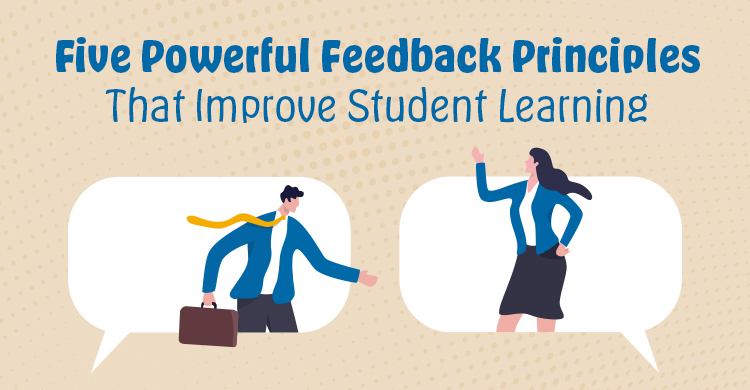Elliott Seif is the author of Teaching for Lifelong Learning: How to Prepare Students for a Changing World.
Introduction
Constructive feedback is a critical aspect of student growth. Think about how a young baseball player becomes a better batter as a coach provides him with feedback in order to improve his swing. Or consider how an ice skater receives feedback on her performance that enables her to improve her technique and skating style.
How can teachers regularly provide constructive feedback as a way to promote student growth, improvement, and openness to change? In a short but powerful essay, Carol Ann Tomlinson (2012) writes about the importance of feedback and five key principles of feedback that developed out of her own teaching experiences.
Improving Student Learning through Feedback
In the essay, Dr. Tomlinson (from now on called Dr. T.) recalls Heather, a student in one of her English classes who was a good writer. Dr. T. worked hard to provide Heather with helpful feedback and praise that would make her an even better writer, and she thought she was really helping Heather to improve her writing. But after Heather had graduated and gone on to college, Dr. T. met her mother in a local store and asked her whether Heather was doing writing that she enjoyed in college. In response, Heather’s mother said, “Last week she (Heather) told me that for the first time in her life she was learning to become a better writer.”
This comment was “a punch in the stomach” to Dr. T., but she used this negative experience to try to figure out why Heather didn’t feel that her writing had improved in Dr. T.’s class (and why the other students in the class probably felt the same way). Dr. T. realized that she had praised what Heather had written, but she “had no [clear] mechanism for helping her get better.”
Due to this insight, Dr. T. spent some time rethinking her teaching of writing. A few years later, in another course, she used the following five feedback principles to improve the writing abilities of her students:
- Develop and share core target goals. The first step in improving learning is to develop a clear target for improvement and to share that target with students. What is it that you really want your students to improve? What is your focus? Without a clear target, how can you know if you are helping your students improve? Unfortunately, many teachers often do not have a focused, targeted goal for improvement. And often, even when there is clarity, it is not shared with students. Thus, Dr. T. made it a point to explain to her college students that her target was to help them develop their power as writers and thinkers.
- Clarify and share the key elements of excellence for the targeted goals, along with progressions for growth for each element. In order to “turn good writers into stellar ones—and adequate writers into good ones,” Dr. T. had to determine what poor, good, and excellent writing look like. What are the characteristics of each? And how do you create a road map leading from poor to good and from good to excellent? Dr. T. shared the key elements of writing excellence with students in a rubric format, along with a progression of growth for each criterion.
- Give precise feedback and suggest specific ways for students to improve their work. Two key words here are “precise” and “specific.” Given the current level of student work, what precise feedback and specific suggestions for next steps will help students make improvements? The clarity of good writing elements and the development of a writing improvement process helped to transform her formerly vague and general feedback into useful, precise feedback and specific, helpful suggestions. Thus, Dr. T. gave her students precise and specific feedback on how to improve their writing assignments.
- Ask students to consider which components of your feedback are useful, which are not, and why, and ask them to develop plans for improvement. After receiving precise feedback, students wrote notes to Dr. T. indicating “which elements of the feedback seemed useful to them and which elements seemed off target.” They also wrote a brief plan for how they would use the helpful feedback to improve their writing. When there were misunderstandings in interpreting her feedback, Dr. T. met with the student briefly after class. This changed the improvement process from one that was being done to students to one that was being done with students! It also “customized” (differentiated) the learning process so that students developed their own unique plan and “owned” the result. And, finally, it gave her students a chance to learn how to analyze their own writing strengths and weaknesses, increasing the possibility of significant long-term results.
- Don’t grade students through the improvement process! Dr. T. realized that her early grading of writing got in the way of student improvement. As she puts it, “many [students] were so focused on getting the right answer that actual learning was a sidebar.” So she decided not to grade any writing until near the end of the semester! The upshot was that, during the early part of the semester, the students developed a true learning community that helped them all improve their writing.
These five principles, taken together, create a powerful process that all teachers can use to improve student learning for many different learning targets, such as persuasive essay writing, research skills, science projects, problem-solving techniques, reading strategies, and other major goals teachers may want to work on with their students. The five principles can be adapted to all grade levels and all subjects.
Teacher Learning, Growth, and Feedback
While a major result of Dr. T.’s analysis of her feedback issues is the five principles of feedback, another important insight she also offers us in her essay is her own attitude toward failure, improvement, and growth. As she writes in her essay, “When I am on my game as a teacher, I make mistakes, just as I do when I’m off course. The difference is that when I’m paying attention, I learn from my mistakes and inch forward in understanding my profession.” Unfortunately, many teachers don’t deal with teaching challenges as well as Dr. T. does. Many teachers are ashamed of their teaching problems. Many often hide instructional mistakes, problems, and challenges behind the closed door of the classroom and don’t use their problems and challenges as opportunities for learning and growth.
Some schools and districts understand that teacher evaluations create opportunities for feedback, improvement, and new learning, but, in many cases, teaching problems are equated with failure, and the typical teacher evaluation process often deals with problems and mistakes through a negative judgment lens, rather than treating them as learning opportunities. This attitude ultimately reinforces the desire to hide mistakes, failures, and problems, so that little or no progress is made in improving teaching over time.
As a profession, we need to take Dr. T.’s personal attitude toward improving her teaching to heart. Teaching problems, failures, and mistakes should be viewed as opportunities for improving and refining teaching. In fact, the five feedback principles cited above can also be used as a method to improve teaching experiences. Let’s use “teacher learning moments,” garnered through teacher self-evaluations and teacher observations, to set teacher growth targets; clarify what excellence and progress mean; observe and give specific, precise feedback; and ask teachers to evaluate feedback and develop plans for change. Let’s develop positive, nonthreatening, nonjudgmental environments so that teachers can work on improving their craft in a comfortable setting. This, too, is an important lesson we can learn from Dr. T.’s experience.
——————
Learning occurs in many ways, and we can’t, nor should we, always target the exact learning that will occur with our students. But one aspect of our teaching responsibility is to be clear about those things that we think are important for our students to learn and improve on. Once we clarify and focus on core learning targets, how do we insure that our students improve their learning in these areas? The feedback principles and practices described by Dr. T. provide us with an explicit process for improving targeted student learning. And they are also invaluable in helping teachers grow and become more competent over time.
Reference
Tomlinson, C. A. (2012). One to grow on/What Heather taught me. Educational Leadership, 70(1), 88–89.






